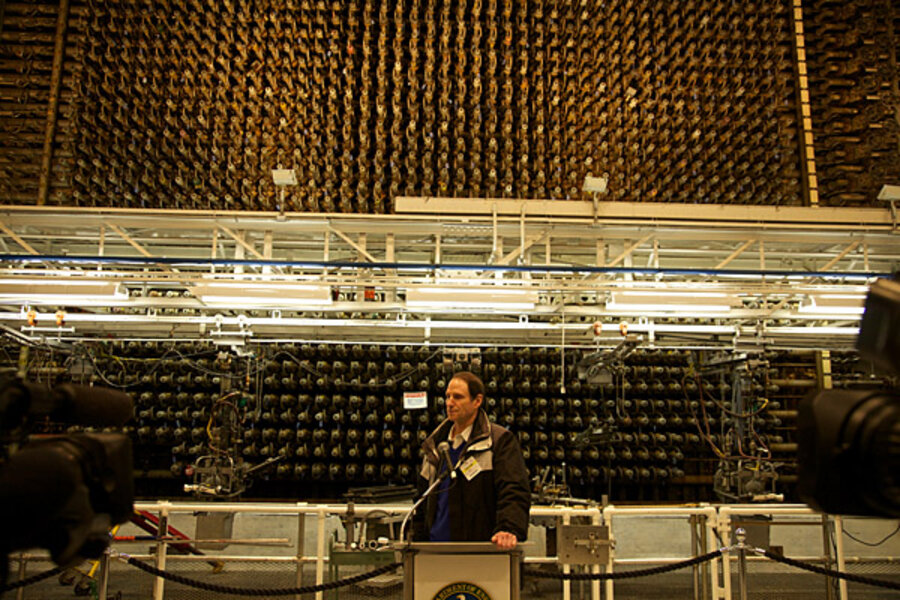Former Manhattan Project nuclear plant leaking radioactive waste
Hanford, Washington, was, along with Oak Ridge, Tennessee, one of the two Manhattan Project nuclear plants that provided fissile material for the bombs dropped on Japan that ended World War Two.
The past is coming back to haunt the site, as last week Washington governor Jay Inslee characterized news about a major leak of highly toxic sludge from a single-wall storage tank at the Hanford Nuclear Reservation as a “perfect radioactive storm.”
The Hanford Nuclear Reservation currently houses 149 single-wall nuclear waste storage tanks, along with 28 newer tanks with double walls. They contain residue from decades of refining plutonium for nuclear weapons, roughly 56 million gallons of highly radioactive waste in aged and corroded underground storage tanks. Since World War II, Hanford Nuclear Reservation facilities have leached roughly one million gallons of radioactive waste has leached into the surrounding soil and groundwater beside the Columbia River, with specialists estimating that the newly discovered leak may be adding an additional 150-300 gallons a year, though no one knows when it began. In 1989 the Department of Energy assumed responsibility for safely disposing of this waste, which threatens to leak into the bordering Columbia River and affect downstream industry, habitat and human health. (Related article: Who will Pay for Nuclear Power Plant Cleanup?)
The news could not come at a worse time, as Washington mandatory budget cuts could impact any response.
Inslee said, “I am alarmed about this on many levels. This raises concerns, not only about the existing leak... but also concerning the integrity of the other single-shell tanks of this age.”
So, how much to tidy the site? According to a new Department of Energy report, cleaning up the Hanford Nuclear Reservation will now set back taxpayers a cool $114.8 billion, an increase from the 2012 estimate of $112 billion.
But wait, there’s more, as the TV pitchmen say.
The DOE "2013 Hanford Lifecycle Scope, Schedule and Cost" report includes annual budgets of more than $3 billion for the site annually up to 2020, but in fact the 586-square-mile Hanford Nuclear Reservation typically receives a little more than $2 billion annually for environmental cleanup, a funding level that the DOE expects to continue for the foreseeable future.
Final decisions for some Hanford Nuclear Reservation projects have yet to be made, for which the lifecycle report is required to make a plausible, upper-range estimate.
So, when does the DOE estimate that the Hanford Nuclear Reservation cleanup will end? At least 2060 and possibly 2070, more than a century after the facility first began contributing to national defense. (Related article: Why is Iran Going Nuclear?)
Final cost? As The DOE "2013 Hanford Lifecycle Scope, Schedule and Cost" report modestly notes, “These estimates account for cost uncertainty because many of the final cleanup decisions have not been made. Once these decisions are made, estimates will be reflected in future Lifecycle Reports.”
The end result of all this, stripped of its dry bureaucratese is that decommissioning the Hanford Nuclear Reservation will take decades, during which time the price tag will only increase.
So, has the Hanford Nuclear Reservation been well managed during the past seven decades?
Not according to the Government Accountability Office, which notes, “By just about any definition, Hanford has not been a well-planned, well-managed or well-executed major capital construction project.” The GAO recommends a halt to construction on the core facility until the design meets nuclear industry guidelines, a new incentive structure to avoid premature reward payments, and an investigation into potentially erroneous payments.
In the meantime, taxpayers can assume only that the bills will rise.
Original source: http://oilprice.com/Energy/Natural-Gas/One-of-Americas-First-Nuclear-Plants-Leaking-Radioactive-Waste.html






